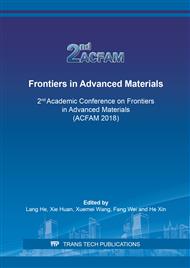[1]
H. Gleiter, Nanostructured materials: basic concepts and microstructure, Acta Mater. 35 (2004) 1-29.
Google Scholar
[2]
K. Lu, J. Lu, Surface nanocrystallization (SNC) of metallic materials-presentation of the concept behind a new approach, J Mat. Sci. Tech. 15 (1999) 193-197.
Google Scholar
[3]
Z. Wang, X. Yong, N.R. Tao, S. Li, G. Liu, J. Lv, K. Lu, The improvement of friction and wear properties of low carbon steel by means of surface nanocrystallization, Acta Metallrugica Sinica. 37 (2001) 1251-1255.
Google Scholar
[4]
L. Waltz, D. Retraint, A. Roos, P. Olier, J. Lu, High strength nanocrystallized multilayered structure obtained by SMAT and co-rolling, Mater. Sci. Forum. 614 (2008) 249-254.
DOI: 10.4028/www.scientific.net/msf.614.249
Google Scholar
[5]
L. Jin, W.F. Cui, X.Song, L. Zhou, The formation mechanisms of surface nanocrystallites in β-type biomedical TiNbZrFe alloy by surface mechanical attrition treatment, Appl. Surf. Sci. 347 (2015) 553-560.
DOI: 10.1016/j.apsusc.2015.04.137
Google Scholar
[6]
S.H. Yi, X.Q. He, J. Lu, Bistable metallic materials produced by nanocrystallization process, Mater Design. 141 (2018) 374-383.
DOI: 10.1016/j.matdes.2018.01.010
Google Scholar
[7]
T. Balusamy, S. Kumar, T.S.N.S. Narayanan, Effect of surface nanocrystallization on the corrosion behaviour of AISI 409 stainless steel, Corro. Sci. 52 (2010) 3826-3834.
DOI: 10.1016/j.corsci.2010.07.004
Google Scholar
[8]
G. Liu, J. Lu, K. Lu, Surface nanocrystallization of 316L stainless steel induced by ultrasonic shot peening, Mater. Sci. Eng. A. 286 (2000) 91-95.
DOI: 10.1016/s0921-5093(00)00686-9
Google Scholar
[9]
H.Q. Ye, X.M. Fan, Surface nanocrystallization of 7A04 aluminium alloy induced by circulation rolling plastic deformation, Trans. Nonferrous Met. Soc. China. 16 (2006) 656-660.
DOI: 10.1016/s1003-6326(06)60272-0
Google Scholar
[10]
K. Zhao, M. Wang, X.L. Cheng, T. Chuan, Mechanism and nanostructure evolution of surface self-nanocrystallization of TC17, Rare Metal Mat. Eng. 42(2013) 2048-2052.
Google Scholar
[11]
D.M. Ba, S.N. Ma, C.Q. Li, F.J. Meng, Surface nanostructure formation mechanism of 45 steel induced by supersonic fine particles pombarding, J Univ. Sci. Technol. B. 15 (2008) 561-567.
DOI: 10.1016/s1005-8850(08)60105-x
Google Scholar
[12]
F.Y. Liu, X.M. Fan, Surface nanocrystallization induced by severe plastic deformation using high-speed rotation wire-brushing, T Mater. Heat Treat. 29 (2008) 162-165.
Google Scholar
[13]
D. Song, A.B. Ma, W, Sun, J.H. Jiang, J.Y. Jiang, D.H. Yang, G.H. Guo, Improved corrosion resistance in simulated concrete pore solution of surface nanocrystallized rebar fabricated by wire-brushing, Corro. Sci. 82 (2014) 437-441.
DOI: 10.1016/j.corsci.2014.01.034
Google Scholar
[14]
A.L. Wen, R.M. Ren, S.W. Wang, S.I. Nishida, Effect of surface nano-crystallization on microstructure and mechanic properties of commercial pure titanium, Key Eng. Mat. 261-263 (2004) 1605-1610.
DOI: 10.4028/www.scientific.net/kem.261-263.1605
Google Scholar
[15]
X.N. Guan, J.H. Jiang, J.Q. Chen, A.B. Ma, D. Song, X.B. Li, Effect of surface nanocrystallization on electrochemical corrosion behaviours of Cu-Mg alloy, Trans. Nonferrous Met. Soc. China 27 (2017) 477-485.
Google Scholar
[16]
F.H. Sun, Z.M. Zhang, H.S. Shen, M. Chen, Deposition and characterization of ultra-smooth nanocrystalline diamond films using a graphite-grid assisted hot filament CVD method, Mater. Sci. Forum. 532-533 (2006) 249-252.
DOI: 10.4028/www.scientific.net/msf.532-533.249
Google Scholar
[17]
J.Y. Huang, Y.T. Zhu, H. Jiang, A.V. Hamza, Abnormal strain hardeningin nanostructured titanium at high strain rates and large strains, Acta Metallic. 49 (2001) 1497-1502.
Google Scholar
[18]
N.R. Tao, Z.B. Wang, W.P. Tong, M.L. Sui, J. Lu, K. Lu, An investigation of surface nanocrystallization mechanism in Fe induced by surface mechanical attrition treatment, Acta Mater. 50 (2002) 4603-4616.
DOI: 10.1016/s1359-6454(02)00310-5
Google Scholar
[19]
Z.J. Cheng, D. Song, J.Y. Jiang, J.H. Jiang, Microstructure characteristic and electrochemical corrosion behavior of surface nano-crystallization modified carbon steel, J Iron Steel Res., Int. 23 (2016) 1281-1289.
DOI: 10.1016/s1006-706x(16)30189-3
Google Scholar
[20]
K.Y. Zhu, A. Vassel, F. Brisset, K. Lu, J. Lv, Nanostructure formation mechanism of α-titanium using SMAT, Acta Mater. 52 (2004) 4101-4110.
DOI: 10.1016/j.actamat.2004.05.023
Google Scholar
[21]
A.Q. Lv, G. Liu, C.M. Liu, Microstructural evolution of the surface layer of 316L stainless steel induced by mechanical attrition, Acta Metallrugica Sinica. 40 (2004) 943-947.
Google Scholar
[22]
H. Zhang, G. Liu, Z. Hei, K. Lu, J. Lv, Surface nanocrystallization of AISI 304 stainless steel induced by surface mechanical attrition treatment I. Structure and property, Acta Metallrugica Sinica. 39 (2003) 347-350.
DOI: 10.1016/s1359-6454(02)00594-3
Google Scholar
[23]
D.M. Ba, S.M. Ma, C.Q. Li, T.Y. Xiong, Investigation of Surface Nanocrystallization of 38CrSi Steel by SFPB, Mater. Eng. 12 (2006) 3-7.
Google Scholar
[24]
D. Song, J.H. Jiang, X.N. Guan, Y.X. Qiao, X.B. Li, J.Q. Chen, J.P. Sun, A.B. Ma, Effect of surface nanocrystallization on corrosion resistance of the conformed Cu-0.4%Mg alloy in NaCl solution, Metals. 8 (2018) 765.
DOI: 10.3390/met8100765
Google Scholar
[25]
C.E. Carlton, P.J. Ferreira,What is behind the inverse Hall-Petch effect in nanocrystalline materials, Acta Mater. 55 (2007) 3749–3756.
DOI: 10.1016/j.actamat.2007.02.021
Google Scholar
[26]
T.F. Dalla, R. Lapovok, J. Sandlin P.F. Thomason, C.H.J. Davies, E.V. Pereloma, Microstructures and properties of copper processed by equal channel angular extrusion for 1–16 passes, Acta Mater. 52 (2004) 4819–4832.
DOI: 10.1016/j.actamat.2004.06.040
Google Scholar
[27]
C.S. Wang, G. Liu, Surface nanostructure and properties of low carbon steel, Iron and Steel. 41 (2006) 60-63.
Google Scholar
[28]
Y.X. Yu, B.L. He, Research reality and prospect about surface self-nanocrystallization and fatigue properties of magnesium alloy welded joints, Materials Review. 27 (2013) 121-124.
Google Scholar
[29]
Y.P. Wang, Y. Li, K.N. Sun, Effect of process duration on the microstructures of fast multiple rotation rolling-induced nanocrystalline layer and its wear properties, J Mater Process Tech. 252 (2018) 159-166.
DOI: 10.1016/j.jmatprotec.2017.07.033
Google Scholar
[30]
D.M. Ba, S.N. Ma, F.J. Meng, C.Q. Li, Friction and wear behaviors of nanocrystalline surface layer of chrome-silicon alloy steel, Surf. Coat. Tech. 202 (2007) 254-260.
DOI: 10.1016/j.surfcoat.2007.05.033
Google Scholar
[31]
J. Zhang, X.B. Ou, Thermal stability of nanocrystalline in surface layer of magnesium alloy AZ91D, Trans. Nonferrous Met. Soc. China. 20 (2010) 1340-1344.
DOI: 10.1016/s1003-6326(09)60301-0
Google Scholar


